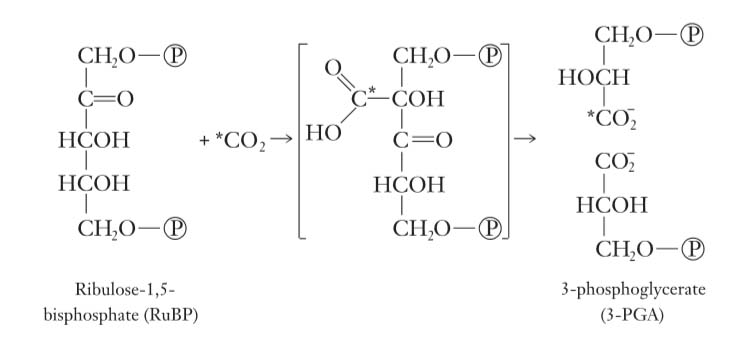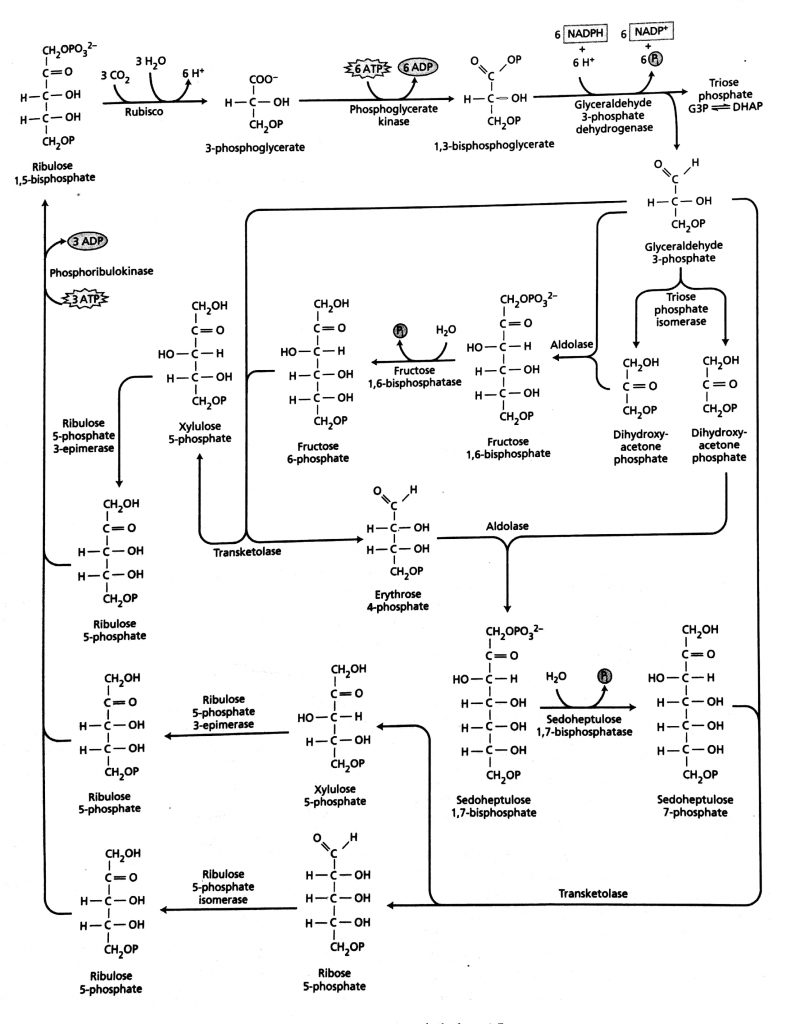It is light independent reaction because light is not directly required for processes but only the products of light reaction (ATP & NADPH2). During these processes carbon dioxide is converted into carbohydrates. It takes place in stroma of chloroplast and involves many reactions, each catalyzed by a different enzyme.
Discovery
To identify the first stable organic product formed following uptake of radiolabeled CO2. In order to achieve this, cultures of the photosynthetic green alga Chlorella were first allowed to establish a steady rate of photosynthesis. 14CO2 was then introduced and photosynthesis continued for various periods of times before the cells were dropped rapidly into boiling methanol. The hot methanol served two functions: it denatured the enzymes,thus preventing any further metabolism, while at the same time extracting the sugars for subsequent chromatographic analysis. When the time of photosynthesis in the presence of 14CO2 was reduced to as little as two seconds, most of the radioactivity was found in a three-carbon acid,3-phosphoglycerate(3-PGA).Thus 3-PGA appeared to be the first stable product of photosynthesis. Other sugars that accumulated the label later in time were probably derived from 3-PGA.

Rubisco-The Enzyme Catalyzing CO2 Fixation
Later in 1954, an enzyme, ribulose bisphosphate carboxylase abbreviated as rubisco was discovered and found to catalyze the combination of CO2 with RuBP to form an unstable 6-C compound that splits into two molecules of 3-PGA. Rubisco is functional in all photosynthetic organisms except in a few photosynthetic bacteria. Also, it is most abundant protein enzyme on earth.
Reduction of 3-PGA

The 3-PGA is removed by reduction to the triose phosphate, glyceraldehyde-3-phosphate.
This is a two-step reaction in which the 3-PGA is first phosphorylated to 1,3-bisphosphoglycerate, which is then reduced to glyceraldehyde-3-phosphate (G3P).
Both the ATP and the NADPH required in these two steps are products of the light reactions and together represent one of two sites of energy input. The resulting triose sugar-phosphate, G3P, is available for export to the cytoplasm, probably after conversion to dihydroxyacetone phosphate (DHAP).
- Regeneration of CO2 acceptor (RuBP)
The original five carbon compound RuBP is regenerated again to accept CO2 from atmosphere. Following reactions takes place during this regeneration.
- G3P isomerizes to dihydroxyacetone phosphate
- 6 carbon fructose 1, 6-bisphosphate is formed by the condensation of two molecules of dihydroxyacetone phosphate (3-carbon compound).
- Fructose 1,6-bisphosphate is dephosphorylated to Fructose-6-phosphate.
- Fructose-6-phosphate (6-C) combines with a molecule of G3P (3-C) and produce erythrose-4-phosphate (4 –C) and xylulose, 5-phosphate (5-C).
- Erythrose-4-phosphate (4 –C) and dihydroxyacetone phosphate (3-C) reacts with each other and form sedoheptolose,1,7-bisphosphate (7-C)
- sedoheptolose,1,7-bisphosphate (7-C) is converted to sedoheptulose 7-phosphate by releasing an inorganic phosphate
- One molecule of Glyceraldehyde-3-phosphate combines with sedoheptulose-7-phosphate and form two five carbon molecules (5-C) and xylulose-5-phosphate (5-C).
- Two molecules of xylulose-5-phosphate and one molecule of ribose-5-phosphate are converted into ribulose-5-phosphate.
- 3 molecules of Ribulose-5-phosphate (5-C) are again phosphorylated to Ribulose 1, 5-Bisphosphate (the original CO2 acceptor) by utilizing ATP of light reaction.
